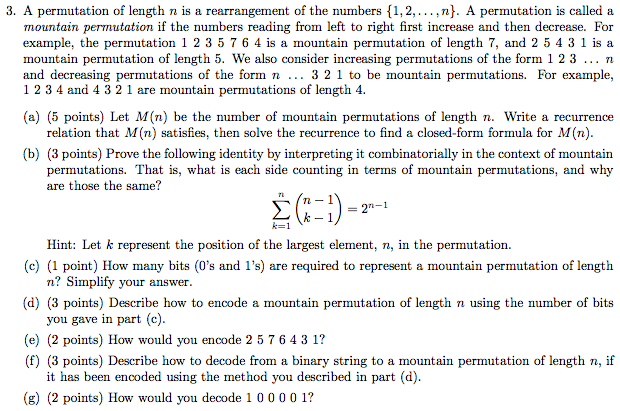
In permutation groups of large degree, the number of Schreier generators to be processed becomes too large, and the deterministic Schreier-Sims algorithm becomes impractical. This lemma is applied recursively, with consecutive point stabilizers G^(i) and G^(i+1) playing the role of K and L.
#100 permute 3 mod
Sims's original construction in is deterministic, and is called the Schreier-Sims algorithm, because it is based on Schreier's Lemma ( ): given K = ⟨ S ⟩ and a transversal T for K mod L, one can obtain |S||T| generators for L. After that, in 43.9 it is explained how a stabilizer chain is stored in GAP, 43.10 lists operations for stabilizer chains, and 43.11 lists low level routines for manipulating stabilizer chains.Ĥ3.7 Randomized Methods for Permutation Groupsįor most computations with permutation groups, it is crucial to construct stabilizer chains efficiently.
#100 permute 3 generator
Let B = be a list of points, G^(1) = G and G^) is labelled with the generator T, and the product of edge labels along the unique path from p to b_i is the inverse of the transversal element carrying b_i to p.īefore we describe the construction of stabilizer chains in 43.8, we explain in 43.7 the idea of using non-deterministic algorithms this is necessary for understanding the options available for the construction of stabilizer chains.

A further discussion of base change is given in section 87.1. An extensive account of basic algorithms together with asymptotic runtime analysis can be found in reference. The concepts of stabilizer chains, bases, and strong generating sets were introduced by Charles Sims in. Many of the algorithms for permutation groups use a stabilizer chain of the group. Gap> g:=AlternatingGroup(5) gap> h:=DirectProduct(g,g) gap> p:=List(,i->Projection(h,i)) gap> ac:=Action(h,AsList(g), > function(g,h) return Image(p,h)^-1*g*Image(p,h) end) gap> Size(ac) NrMovedPoints(ac) IsPrimitive(ac,) (This is useful if a function called internally might try a degree reduction.) If the option cheap is given less work is spent on trying to get a small degree representation, if the value of this option is set to the string "skip" the identity mapping is returned. The methods used might involve the use of random elements and the permutation representation (or even the degree of the representation) is not guaranteed to be the same for different calls of SmallerDegreePermutationRepresentation.

Using GAP interactively, one might be able to choose subgroups of small index for which the cores intersect trivially in this case, the actions on the cosets of these subgroups give rise to an intransitive permutation representation the degree of which may be smaller than the original degree. Note that the result is not guaranteed to be a faithful permutation representation of smallest degree, or of smallest degree among the transitive permutation representations of G. If the cheap option is given, the function only tries to reduce to orbits or actions on blocks, otherwise also actions on cosets of random subgroups are tried. The result is a group homomorphism onto a permutation group, in the worst case this is the identity mapping on G. SmallerDegreePermutationRepresentation tries to find a faithful permutation representation of smaller degree. ‣ SmallerDegreePermutationRepresentation( G ) Similarly, several functions concerning the natural action of permutation groups address stabilizer chains (see 43.6) rather than permutation groups themselves, for example BaseStabChain ( 43.10-1). For the special case of the action of permutations on positive integers via ^, the functions OrbitPerms ( 43.2-1) and OrbitsPerms ( 43.2-2) are provided for this purpose. If one has a list of group generators and is interested in the moved points (see above) or orbits, it may be useful to avoid the explicit construction of the group for efficiency reasons. Therefore all action functions can be applied (see the Chapter 41), for example Orbit ( 41.4-1), Stabilizer ( 41.5-2), Blocks ( 41.11-1), IsTransitive ( 41.10-1), IsPrimitive ( 41.10-7). The action of a permutation group on the positive integers is a group action (via the acting function OnPoints ( 41.2-1)). Gap> LargestMovedPoint( g ) SmallestMovedPoint( g )


 0 kommentar(er)
0 kommentar(er)
